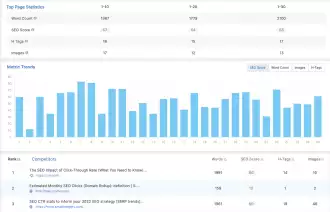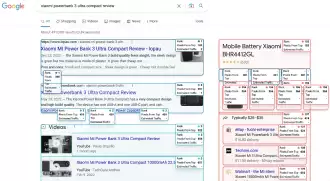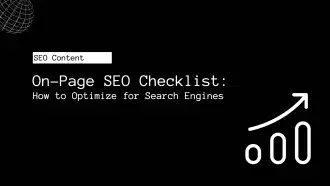You have search engine optimization all figured out, and you’re ready to go for organic search results. You know the basics of keyword optimization, keyword ranking, and backlinks, and you’re eager to push your website up in search engine results.
But organic search is not just about ranking high; it’s also about ensuring that your site gets a decent number of clicks and views.
For a successful campaign, you need an optimally-optimized keyword-heavy title tag, meta description, and keyword-rich URLs. And all of this without compromising on the search engine ranking of your page. Sounds complicated?
It is—but it’s not impossible. We will cover how you can improve the click-through rate (CTR) in organic search results to get more organic traffic.
What is Organic Click-Through-Rate?
Organic click-through rate (CTR) is the number of clicks on the search result out of the total number of organic clicks for a particular keyword. It’s an important metric for marketers as it shows how well their paid ads are performing in comparison to organic results.
Having a paid ad and an organic listing on the first page for the same keyword increases the total SERP real estate and brand presence on the SERP, which can result in a higher click-through rate. However, the organic click-through rate can be increased by focusing on page design, providing relevant content, and using strong meta descriptions.
Elevating the organic click-through rate is important not only because it helps you attract more traffic but also because it implies higher chances of conversion.
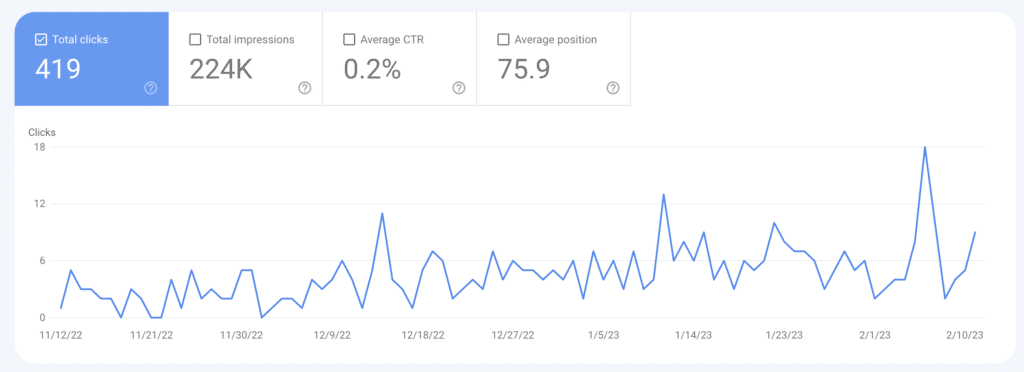
How is Click-Through-Rate Related to SEO?
CTR is an important ranking factor in search engine optimization (SEO) as it shows how many people click on the website after seeing it in a search result. A higher CTR indicates higher organic traffic and ranking, which is vital for a website’s success.
CTR can be increased through SERP manipulation, which is when real humans click on search result listings to drive organic traffic to a website. A study from 2014 showed that when an article was in the top position of a SERH, the CTR was 56%.
This signifies that high-ranking articles with high-quality content are able to attract more clicks. However, if an article has low-quality content and rankings do not reflect that, people may choose to avoid clicking on it.
A high CTR also leads to better organic ranking visibility and visibility in search engine results pages (SERPs). Higher CTRs generally lead to higher page rankings.
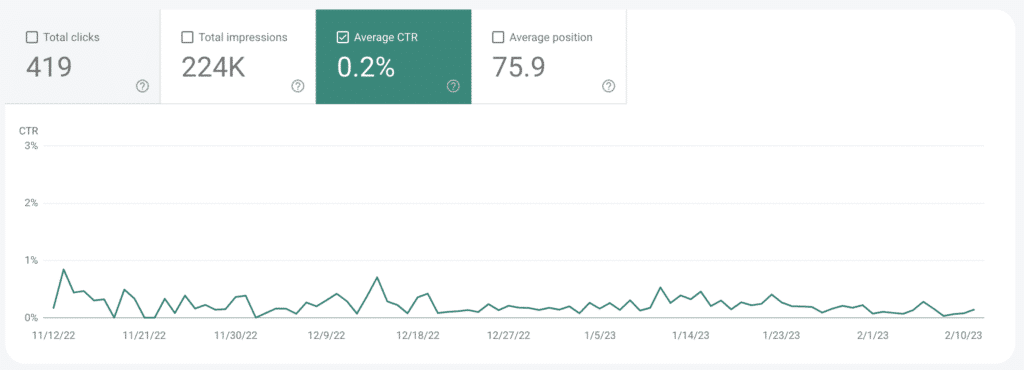
How Can We Improve Organic Click-Through-Rate?
Improving the organic click-through rate (CTR) for Google Search Console (GSC) can be achieved by improving the visibility of organic listings on the search engine result page (SERP). By creating a presence on both organic and paid listings for the keyword, you can increase click-through rates for organic listings.
You can do this by optimizing page titles and meta descriptions to have more relevant and informative messages. Having a presence on both organic and paid listings also can help increase brand visibility. By following these tips, you can improve organic click-through-rate on search engine result pages.
Request Free Review
We start by reviewing your website and then take a look at your current ranking in SERPs.
- Unlock Your Website’s Potential with Our Comprehensive Analysis.
- Outrank Your Competitors with Our Expert Insights and Recommendations.
- Ways for increasing website traffic.
- Get Tailored Recommendations to Achieve Better Results Online.
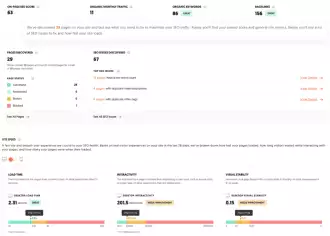
1. Optimize Your Title
When optimizing your title for organic search results, it’s important to include keywords relevant to your search. For example, if you are looking for a used car, keyword phrases such as “used cars” or “yacht for sale” could be relevant. Additionally, placing the keyword early in the title can help draw attention to your listing.
You should also include words that pique user interest, such as “free” or “exclusive.” These terms will attract more attention and help users click through to learn more about your listing.
Finally, incorporating schema markup can improve the visibility of organic search results and help you get higher click-through rates.
2. Optimize Your Meta Description
Meta descriptions are an important factor in driving organic click-through rates. To optimize organic click-through rate, search engine optimization (SEO) strategies must be implemented. The average CTR and average position of a page can be determined using the search console.
Once the organic click-through rate for a page is identified, optimization efforts can start by focusing on pages with the lowest click-through rate. These pages can be prioritized for optimization based on factors such as their average position in search results and their average CTR.
Additionally, meta description optimization strategies, such as including search keywords in the meta description, can help improve organic CTR. By optimizing meta descriptions and other page elements, the organic click-through rate can be increased significantly.
3. Optimize Your URLs
When optimizing your URLs, ensure that they are concise and descriptive, including relevant keywords. This will help improve your click-through rate on organic search results. Another important optimization is to make sure your URLs are easy to read. Using hyphens to separate words in URLs can be helpful if you’re trying to avoid keyword stuffing.
For example, “likes-page.com” is easier to read than “like-page-com.” If you already have a keyword in your URL, it can be helpful to use SERP real estate by having both organic listings and paid ads on the first page of search results.
Besides keyword optimization, search engine optimization (SEO) ranking signals must be incorporated into your URLs to improve your click-through rate and overall organic search performance.
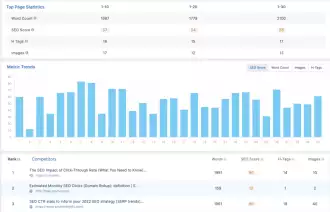
Purely organic keyword Optimization Strategy
As marketers, we all know the importance of keyword optimization. In terms of organic search results, it’s vital to focus on long-tail keywords as they often have higher CTRs than paid search results. This is because search engine algorithm favors those keywords that appear frequently in organic results. The algorithm will also try to ensure that a searcher gets relevant search results for the query they have submitted.
Organic search optimization also includes activities like creating high-quality content on your website and following best practices for website optimization. However, companies should not forget to integrate organic search with other marketing channels as this can result in higher visibility and reach in search engine results pages (SERPs).
A successful organic SEO strategy requires a holistic approach that incorporates both keyword research and optimization activities. Besides, companies should understand how search engines view their content and the interactions between organic and paid search platforms.
Keyword SEO CTR uplift – average rankings by SERP position
Click-through rate optimization is an essential step in search engine optimization (SEO). Click-through rate is a crucial metric that measures the visibility of a website on search engine result pages (SERPs). It represents the percentage of users who click on a search engine result after conducting a search query.
Improved CTR can lead to an increase in organic traffic and, ultimately, improve search engine rankings. However, the click-through rate is not a ranking signal in Google’s algorithm. To improve search engine ranking, it’s important to optimize other aspects of a website, such as page ranking and content quality.
Furthermore, click-through rate optimization requires constant monitoring and adjustments to stay ahead of the competition. If you want your website to gain visibility on search engine results pages, it’s crucial to continuously optimize your SEO efforts and closely monitor your organic traffic trends.
1. SEO CTR for brand vs non-branded keyword intent
Search engine optimization (SEO) strategies such as keyword optimization and keyword research can result in higher search engine traffic. This can result in higher click-through rates for search results. Organic click-through rates for search engine traffic from non-branded queries are significantly lower than those from branded queries. This is due to the high ranking of the top result on non-branded keywords, which may lead users to click away from the search results quickly.
To improve organic keyword click-through rates, it is important to tailor search results by keyword intent type. For example, title tags should be optimized to match the target keyword intent type (for example, title tag ‘dog training guide’ for queries related to dog training). By crafting titles that match the user’s intent, search results can become more compelling and result in higher click-through rates.
2. SEO CTR for generic vs long-tail terms
Generic search queries have a lower click-through rate (CTR) than long-tail keywords in the highly coveted search engine result page (SERP) positions 2-5. This may be due to generic search queries lacking additional context or being less specific than long-tail keywords.
For example, generic search queries for “online shopping” often include broad categories like “shopping online” or “online sales” instead of more specific queries like “online clothing store” or “red dress.”
In addition, branded terms have higher CTRs than non-branded terms, with organic CTRs of 32% and 26% in the first position decreasing to 10% and 9% in the third position. This finding suggests that organic SEO efforts should focus on improving the organic traffic, visibility, and potential customers of top organic results.
3. SEO CTR variation based on the intent type
Click-through rate (CTR) is an important ranking factor in search engine results page (SERP) visibility and success. High-CTR websites can push up in the SERP results to a higher position due to their higher visibility over other websites with similar content. The result of high CTR websites can lead to increased traffic and conversions for businesses.
However, search engine optimization (SEO) practitioners should take into consideration different types of intent when optimizing website content for search queries. For branded keywords, CTRs tend to be higher than for non-branded keywords, with organic CTRs at 32% and 26% in the first position decreasing to 10% and 9% in the third position. For commercial intent searches, there is a much bigger drop between positions 1 and 2 than other types of intent.
4. SEO CTR based on SERP features
CTR, or click-through rate, is an important metric for search engine optimization (SEO) due to its influence on visibility and success on search engine result pages (SERP). It measures the percentage of people who click on a website after conducting a search query.
CTR is not a ranking signal in Google’s algorithm, despite some controversy surrounding this topic in the SEO community. However, businesses can use CTRs for the first 3 positions of both branded and non-branded terms to determine which areas of their website are most relevant to search queries. By measuring the CTR of your ranking pages, you can determine the number of organic visitors to your website. This helps you optimize your online marketing efforts and increase your conversion rate.
CTR is an important metric for search engine optimization (SEO). It directly impacts visibility and success of a website on search engine result pages (SERP). The click-through rate of a website largely depends on three factors: relevancy, quality, and promotion. A high click-through rate indicates that there is strong demand for that particular website among searchers looking for information about a particular topic. As such, it is an indicator of good online marketing performance and user engagement.
Request Free Review
We start by reviewing your website and then take a look at your current ranking in SERPs.
- Unlock Your Website’s Potential with Our Comprehensive Analysis.
- Outrank Your Competitors with Our Expert Insights and Recommendations.
- Ways for increasing website traffic.
- Get Tailored Recommendations to Achieve Better Results Online.

Here is a Summary of Our Key Findings:
– Click-through rate (CTR) is the percentage of clicks that result in a click-through. It is an important metric for marketers to track as it shows how effective their ads are.
– High click-through rates can result in higher revenue and more visibility for a brand. However, high click-through rates also come with higher expenses, as they require more ads to be shown. In any case, it’s vital to optimize your click-through rate by testing different advertising strategies and landing page optimization.
– More clicks (“high CTR”) earns more traffic regardless of ranking on search engine results pages (SERPs). This means that high CTR does not just equate to ranking high but with higher traffic and conversions as well.
– Google could count clicks as a type of vote to rank content in search results. It could also use click metrics such as initial clicks and average duration on a website or page to determine the ranking of content.
– Another factor that influences click-through rate is ‘dwell time’. A longer dwell time signifies an intent from the user and indicates a higher likelihood of conversion, thus leading to higher revenues.
The #1 Result In Google Gets 27.6% of All Clicks
According to our data, the top organic search result receives almost three-quarters (73.1%) of all clicks on the Google search page. This result is 10 times more likely to receive a click than results in the #10 position. The top organic search result also receives more than two-thirds (68.7%) of all clicks on the Google search page. By contrast, results in the #3-#10 positions combined receive only 13.3% of all clicks on google search. Moving up one spot in the search results can result in an additional 2.8% increase in click-through rate (CTR). This shows just how important it is to be at the top of Google’s search results page.
Organic CTR Spikes At Position #8… And Again At Position #2
Organic search results, such as organic search results from position #8 and position #2 in Google, often receive higher click-through rates than organic search results from other positions. This is likely due to the fact that position #8 in Google is typically displayed prominently above the fold, while search results from other positions are typically buried within a page of results. As a result of this, position #8 organic search results receive more visibility and visibility than search results from other positions. Additionally, organic search results from position #2 are often displayed above the fold, allowing searchers to quickly decide on which result to click on. This visibility and visibility of organic search results from position #2 and #8 likely accounts for their higher click-through rates relative to organic search results from other positions.
Moving Up One Position Increases CTR By 32.3%
Moving up one position in Google search engine results in an average CTR of 2.8%. The average relative CTR increase from moving from position #10 to position #9 is 11%, which means that you will get 11% more clicks when moving from position #9 to #8 than when staying in position #10. Moving from position #2 to #1, with a relative CTR boost of 74.5%, results in the greatest average relative CTR increase. Clicks are the number of times people click on a particular link in search engine results page. So, moving up one search engine result position will result in more clicks and hence higher click-through rate (CTR).
Most Websites Get 25.1 Clicks Per Query
Queries that websites rank for in Google have very few impressions, with 90.3% of queries having 10 or fewer impressions. This means that most queries result in a small number of clicks, with 25.1 clicks per query. To improve the ranking of their website in Google search results, website owners can optimize keyword optimization and include title tags that provide keyword information and a brief summary of the page. Longer title tags also tend to result in higher organic click-through rate (CTR). Additionally, keyword optimization and relevance of content to search queries can help websites gain visibility in Google search results.
Question and Non-Question Titles Have a Similar CTR
Determining which type of title has a higher CTR is an important task to ensure optimal performance on search engine results pages (SERP). Studies have shown that questions can boost CTR on social media. When search engine results pages display both question and non-question titles, it is often beneficial to display question titles as they have a higher click-through rate (CTR).
However, it is not necessary to always display question titles in order to achieve high click-through rates. In addition, page titles with search query term matches have a higher click-through rate than those without search query terms. Therefore, it is critical for marketers to carefully analyze the search queries on SERP and determine which keyword phrases and individual words contribute to high CTRs.
Title Tags Between 40 to 60 Characters Have The Best CTR
The title tag is the most important element of a search engine optimization (SEO) optimization strategy. The title tag should be between 40 and 60 characters in length and must include the keyword(s) relevant to the page’s focus.
Additionally, it is important to include long-tail keyword(s) that are relevant to the page’s niche. When optimizing titles, it is also beneficial to use keywords that are similar to the page’s focus. This can improve click-through rate (CTR) and search engine ranking (SERP) results.
It is also beneficial to use titles with positive sentiment, as these tend to have higher CTRs. In summary, the title tag is an essential part of a successful SEO optimization strategy, and it must be keyword-rich and include relevant keywords in order to result in higher search engine ranking results.
Keyword-Rich URLs Are Correlated With a Higher CTR
Query-keyword matches in URLs result in higher click-through rates (CTR) than URLs with no query-keyword matches. When a search engine such as Googlebot queries a webpage, it looks for any keyword-rich text strings within the page’s HTML code. When search engine bots find keyword-rich text strings on a page, they can prioritize them over other content and engage more deeply with users.
In other words, search engine bots prioritize keyword-rich text strings over regular, non-keyword text strings and engage more deeply with users. URLs with words relevant to the page’s content also result in higher click-through rates. This shows that search engine bots are able to engage more deeply with users when they find relevant keyword-rich text strings within a page’s HTML code.
Positive Titles Can Increase Organic Click-Through Rate
Titles are an important part of search engine optimization (SEO). They allow users to quickly understand what the content is about. Titles can be used to improve search results and increase click-through rates for organic search results and ads.
Title tags should include the keyword or keyword phrase that the page is about, as well as a description that provides additional detail about the page.
Organic click-through rate, meaning the likelihood of a user clicking on an organic search result from search engine results page (SERP), depends on multiple factors, including keyword relevance, relevancy of the organic listing, and quality of the organic listing itself.
An organic listing on the first page for a keyword will result in more real estate on a SERP, which can result in increased click-through rates for organic search results and ads. Similarly, moving up from position #9 to #8 on an organic search result page can result in a significant click-through rate boost. To further improve search results and increase click-through rates, it’s important to use relevant and compelling titles for your pages.
Understand Keyword Search Intent
When someone conducts keyword search, they are most likely looking for information on a specific topic. So when writing content for keyword search intent, make sure to focus your efforts on providing the targeted readers with high-quality content that covers the topic in question. Include keywords throughout your article titles, subheadings and even in the opening sentence of each paragraph to help draw attention to this key area of your website. Additionally, provide valuable resource links back to related topics within your article so readers can learn more about what you’ve written about if they wish.
Frequently Asked Questions
What is a good click-through rate SEO?
A click-through rate (CTR) is a metric that measures the percentage of people who click on a search result after it appears in the SERPs. Generally, a higher CTR is considered to be above 10%. Additionally, increasing the CTR of your search engine result page listing can be a very positive ranking signal.
CTR is very similar to traffic generation and conversion rates, in that if no one clicks on a search result after it appears in the SERPs, it is considered a wasted effort. So, make sure to design high-quality search engine result pages that are likely to result in clicks from potential customers.
What is the difference between clicks and impressions in SEO?
The difference between clicks and impressions in SEO is that clicks indicate the number of people who click on a search result, while impressions refer to the number of people who view a search result.
CTR (click-through rate) is a calculated metric that tells you how many people clicked through out of the total number of people who saw it.
Organic CTR (click-through rate) is important as it measures how many people saw your search result and how many clicked through.
Questions have a 14.1% higher CTR than other titles.
Having an exact keyword in the URL can increase CTR by 45%.
Does Pay Per Click Help SEO?
Yes, Pay-per-click (PPC) is one of the best ways to help improve your website’s search engine optimization. PPC ads always appear alongside organic search results on search engine result pages (SERPs), allowing businesses to pay only when consumers click on their ads. This helps businesses to focus on high-quality content rather than paying for traffic that may not be interested in their products or services.
Increasing the click-through rate (CTR) of a search engine results page (SERP) listing can be a very positive ranking signal for SEO. CTR is the percentage of clicks on an organic search result that result in a conversion or action. A high CTR indicates that your search engine optimization efforts are paying off and that people are clicking on your ads more often than not.
How Can We Improve Organic Click-Through-Rate?
To improve organic click-through-rates, you can try the following strategies:
– Increase your digital footprint by having both a paid ad and an organic listing for the same keyword. This will push competition out of the way and result in more clicks for the keyword.
– Tracking organic rankings for PPC ad keywords can help improve click-through rates. You can use this information to optimize your search engine results page (SERP) for better click-through rates.
– Make sure your search engine results page (SERP) is optimized for better click-through-rates. This includes using keyword density, keyword selection, and keyword placement wisely.
– Increase brand presence and credibility by being consistent with your ranking on the SERP. This will help you build trust with potential customers and increase the chances of them clicking through to your website.
What are some factors that can affect click-through rate (CTR)?
There are a few factors that can affect click-through rate (CTR). Some of these include:
– The total number of clicks on a link divided by the number of impressions of the link.
– The quality of the title tag can affect CTR, as well as how closely it matches the user’s search intentions.
– The content of the link can also influence how likely a person is to click on it.
– The positioning of the link can have an effect on CTR, as people are more likely to click links that are higher on the page.
– The design of the link, including the visuals and colors, can also play a role in getting people to click.
What are some common mistakes that businesses make when it comes to CTR?
Some of the most common mistakes businesses make when it comes to CTR (click-through rate) are not understanding the differences between industries and campaigns, not tracking CTR data, not taking advantage of SEO opportunities to improve CTR, and not testing and experimenting with campaigns to improve click-through rate.
Conclusion
If you want to boost your organic click-through rate, you need to focus on a number of factors. These include keyword optimization and optimization of your website’s architecture. However, when it comes to organic search engine optimization strategies, keyword research is the key.
A good keyword strategy involves finding high-quality search queries and keyword variations that match those search queries.
You can use tools such as keyword research tools to find high-quality keyword variations for your website.
Apart from keyword optimization strategies that focus on higher ranking search results, you must also optimize your website using other search engine optimization strategies like creating optimized content and using social media optimization strategies.
Request Free Review
We start by reviewing your website and then take a look at your current ranking in SERPs.
- Unlock Your Website’s Potential with Our Comprehensive Analysis.
- Outrank Your Competitors with Our Expert Insights and Recommendations.
- Ways for increasing website traffic.
- Get Tailored Recommendations to Achieve Better Results Online.


